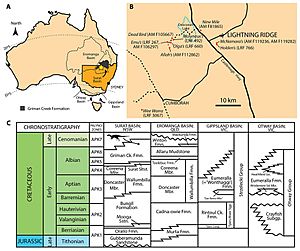Weewarrasaurus facts for kids
Quick facts for kids Weewarrasaurus |
|
|---|---|
 |
|
| Pictures and 3D models of the main fossil | |
| Scientific classification |
|
| Kingdom: | Animalia |
| Phylum: | Chordata |
| Clade: | Dinosauria |
| Order: | †Ornithischia |
| Suborder: | †Ornithopoda |
| Genus: | †Weewarrasaurus Bell et al., 2018 |
| Type species | |
| †Weewarrasaurus pobeni Bell et al., 2018
|
|
Weewarrasaurus is a type of dinosaur called an ornithopod. It lived during the Late Cretaceous period. This was a long time ago, when dinosaurs roamed the Earth. Its fossils were found near Lightning Ridge in New South Wales, Australia. The only known species is Weewarrasaurus pobeni. We know about it from a special jawbone fossil. This jawbone was preserved in a beautiful opal gemstone. Scientists think Weewarrasaurus lived alongside other ornithopod dinosaurs. These other dinosaurs were of different sizes and types.
Discovery and Naming
The main fossil for Weewarrasaurus is called the type specimen. Its number is LRF 3067. It is made of two parts of a jawbone that still have teeth in them. Miners first found this fossil in 2013. They were working in a mine at a place called Wee Warra. This area is part of the Griman Creek Formation. It is close to the town of Lightning Ridge in New South Wales, Australia. The fossil broke while they were digging it out.
An Opal dealer named Mike Poben found the fossil. He was from Adelaide. He got a bag of rough opals from the miners. He was the first to realize it was a fossil. The fossil was special because it was preserved in green-blue opal. This type of gemstone is very famous in that area. In 2014, a paleontologist named Phil Bell saw the fossil. He understood how important it was. So, Mike Poben gave the fossil to the Australian Opal Centre. This center has the largest collection of opal fossils in the world.
Phil Bell and his team later named this new dinosaur. They published their findings on December 4, 2018. Their study looked at all the ornithopod fossils from the Griman Creek Formation. The name Weewarrasaurus comes from the Wee Warra fossil site. This is where the fossils were found. The word saurus comes from Greek and means "lizard." The second part of the name, W. pobeni, honors Mike Poben.
The opal patterns on the fossil helped scientists. They could tell that both parts of the jawbone came from the same dinosaur. These patterns also showed how far apart the two jaw sections were originally. Besides the main opal fossil, scientists found another jawbone. This second jawbone, LRF 766, was also given to this new species. It looked very similar to the first one. It was found in a place called Holden's locality. This area is also near Lightning Ridge and part of the Griman Creek Formation.
See also
 In Spanish: Weewarrasaurus pobeni para niños
In Spanish: Weewarrasaurus pobeni para niños


